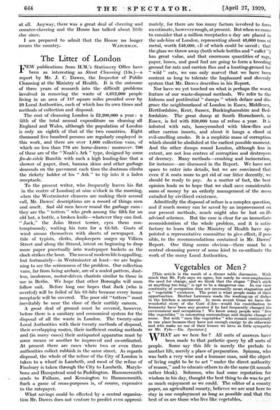The Litter of London
F' publications from H.M.'s Stationery Office have been as interesting as Street Cleansing (15s.)—a report by Mr. J. C. Dawes, the Inspector of Public Cleansing at the Ministry of Health. It is the outcome of three years . of research into the difficult problems involved in removing the waste of 4,612,000 people living in an area of 117 square miles presided over by 29 Local Authorities, each of which has its own times and methods of collection and disposal.
The cost of cleansing London is £2,200,000 a year : a fifth of the total annual expenditure on cleaning all England and Wales, although the population of ,London is only an eighth of that of the two countries. Eight thousand five hundred persons are regularly employed in this work, and there are over 1,000 collection vans, of which no less than 770 are horse-drawn : moreover, 700 of these are of the "Noah's Ark " type, designed by some fin-de-sie,ele Bumble with such a high loading-line that a shower of paper, dust, banana skins and other garbage descends on the pavement each time the dustman climbs the rickety ladder of his " Ark " to tip into it a laden receptacle.
To the present writer, who frequently leaves his flat 'in the centre of London) at nine o'clock in the morning, when the Westminster cleaners are making their second call, Mr. Dawes' descriptions are a record of things seen and smelt. Sad old men hover round the garbage cans : they are the " totters " who grub among the filth for an old hat, a bottle, a broken knife—whatever they can find. " Jack," the John Street terrier, eyes them con- temptuously, waiting his turn for a tit-bit. Gusts of wind amuse themselves with sheets of newspaper. A tide of typists, clerks, shopkeepers surges up Villiers Street and along the Strand, intent on beginning to drop more paper punctually into wastepaper baskets as the clock strikes the hour. The mess of modern life is appalling, but fortunately—in Westminster at least—we are begin- ning to see the seriousness of the problem. Our collection vans, far from being archaic, are of a sealed pattern, dust- less, inodorous, motor-driven chariots similar to those in use in Berlin. We hope that other Boroughs will soon follow suit. Before long one hopes that Jack (who is overfed) will be foiled of his tit-bits because every house receptacle will be covered. The poor old "totters" must inevitably be near the close of their earthly careers.
A great deal of ground must be covered, however, before there is a sanitary and economical system for the disposal of all the waste in London. The twenty-nine Local Authorities with their twenty methods of disposal, their overlapping routes, their inefficient costing methods and (in many cases) their antiquated apparatus must by some means or another be improved and co-ordinated. At present there are cases where two or even three authorities collect rubbish in the same street. As regards disposal, the whole of the refuse of the City of London is taken to a wharf in Lambeth, and most of the refuse of Finsbury is taken through the City to Lambeth. Maryle- bone and Hampstead send to Paddington. Hammersmith sends to Fulham, and Kensington to Hammersmith. Such a game of cross-purposes is, of course, expensive to the ratepayer.
What savings could be- effected by a central organiza- tion Mr. Dawes does not venture to predict even approxi- mately, for there are too many factors involved to form an estimate, however rough, at present. But when we come to consider that a million receptacles a day are placed in the ash-bins of London, representing about 43,009 tons of metal, worth £43,000, all of which could be saved ; that the glass we throw away (both whole bottles and " cutlet ") has great value, and that enormous quantities of rags, paper, bones, and good fuel are going to form a breeding ground for rats and carrion flies and a hunting-ground for " wild " cats, we can - only marvel that we have been content so long to tolerate . the haphazard and slovenly system that Mr. Dawes describes in his Report.
Nor have we yet touched on what is perhaps the worst feature of our waste-disposal methods. We refer to the hideous and pestilential " dumps " which deface and dis- grace the neighbourhood of London in Essex, Middlesex, Hertfordshire, Kent, Sussex, Buckinghamshire and Bed. fordshire. The great dump at South Hornchurch, in Essex, is fed with 350,000 tons of refuse a year. It is infested with rats, honeycombed with blow-flies and other carrion insects, and about it hangs a cloud of evil-smelling smoke. It is a mephitic mass of corruption which should be abolished at the earliest possible moment. And the other dumps round London, although less in extent, are not less centres of corruption and destroyers of decency. Many methods—crushing and= incineration, for instance—are discussed in the Report. We have not space to enter into details, but we are convinced that even if it costs more to get rid of our litter decently, we should be ready to pay. As a matter of fact, the best opinion leads us to hope that we shall save considerable sums of money by an orderly management of the mess entailed by civilized existence.
Admittedly the disposal of refuse is a complex question, and if much money can be saved by an improvement on our present methods, much might also be lost on ill- advised schemes. But the case is clear for an immediate reconsideration of the whole problem, and it is satis- factory to learn that the Ministry of Health have ap- pointed a representative committee to give effect, if pos- sible, to the recommendations contained in Mr. Dawes' Report. One thing seems obvious—there must be a central cleansing power of some kind to co-ordinate the work of the many Local Authorities.








































 Previous page
Previous page